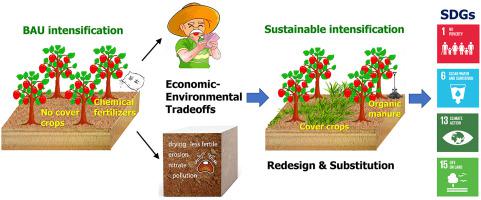Journal of Cleaner Production ( IF 9.7 ) Pub Date : 2021-02-25 , DOI: 10.1016/j.jclepro.2021.126497 Xiaodong Gao , Xining Zhao , Pute Wu , Min Yang , Miaotai Ye , Lei Tian , Yufeng Zou , Yong Wu , Fusuo Zhang , Kadambot H.M. Siddique

|
Agricultural intensification has turned the drylands-dominated Loess Plateau (LOP) of China into the world’s largest apple production area, which has greatly contributed to increasing farmer’s income and reducing rural poverty in the past two decades. However, substantial environmental trade-offs are evident, including (i) severe deep soil desiccation, which lowers resistance to extreme droughts; (ii) low soil organic carbon sequestration, which undermines apple tree’s ability to mitigate climate change; (iii) high soil erodibility, which increases the risks for orchards suffering serious erosion; and (iv) severe residual nitrate pollution, which threatens drinking water and planetary health. We propose a conceptual framework for addressing those environmental externalities, which will incorporate a nexus of scientists and technicians, policymakers, social enterprises, and smallholder farmers (SPES) to emphasize good governance, green-production technologies (GPTs), and collaboration as the route toward sustainable intensification and the realization of SDG 1 (alleviation of rural poverty), SDG 6 (reduction of soil and water pollution), SDG 13 (provision of important carbon sinks), and SDG 15 (positive water cycling and soil and water conservation). This framework may also offer insight into the sustainable development of orchards in dryland areas with similar environmental issues.


















































 京公网安备 11010802027423号
京公网安备 11010802027423号